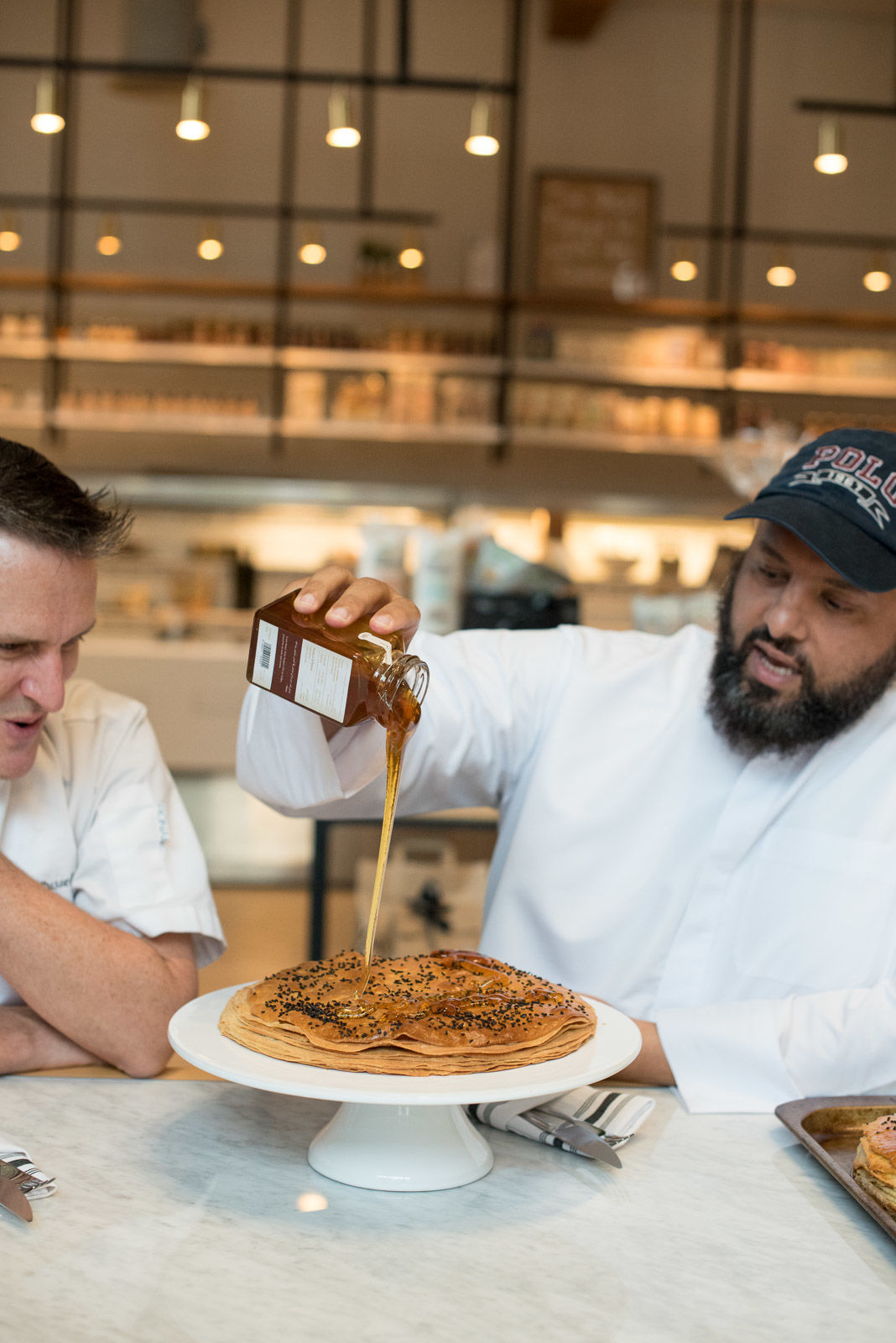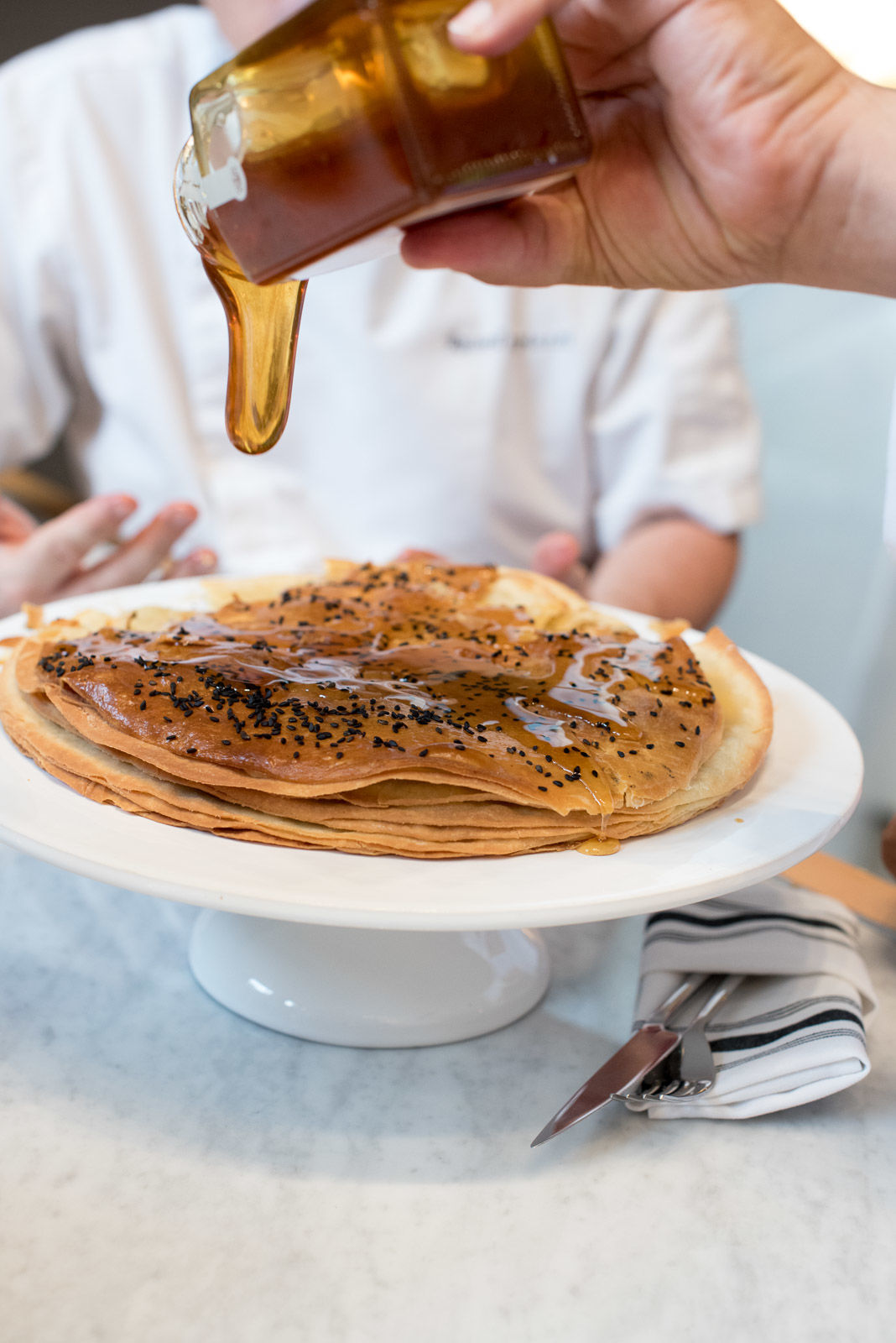What are your most vivid memories of food from childhood? My first ever experience of tasting Yemeni honey started as a child when my Mum baked a classic Yemeni dish called Bint Al Sahn (which means daughter of the plate). It’s a multi-layered, bread-like dessert that’s infused with black seeds (black cumin). As soon as it comes out of the oven it’s drenched with Yemeni Sidr honey. The deep and rich flavour of the Sidr, with notes of caramel and toffee, over a baked, hot, eggy, buttery pastry is unforgettable. My siblings and I would use our fingertips to tear off morsels and bunch them up into honey-laden balls to pop into our mouths. It’s imprinted on my memory – in the part of the brain that holds all extraordinary, gastronomic experiences.
Sabayah is a similar version from the Hadramout region of Yemen – the centre is slightly denser and more doughy. Some people like to brush more beaten egg on the top in the last five minutes of cooking so it turns a cloudy white. Some villagers make another variation and sprinkle sultanas and a little bit of cinnamon between the layers.
Bint Al Sahn (Yemeni Honey Cake)
A rich, buttery, traditional Yemeni dessert made of layers of thinly rolled dough and drizzled with honey. Traditionally served with hot, black tea. The amount of honey poured over is a matter of personal taste but it's usually very generous.
Ingredients
- 1 tsp dried yeast
- 2-3 tbsp water 1/4 cup
- 560 g strong white bread flour 4 cups
- 4 large eggs plus 1 egg yolk
- 170 g ghee or melted butter 1 cup
- 1 tsp salt
- vegetable oil
- 1 tbsp black cumin seeds
- 200 ml raw Yemeni honey or more to taste
Instructions
-
Dissolve the yeast in half of the water at room temperature. Mix the flour, 4 eggs, 175ml melted ghee or butter, salt, and yeast mixture together and knead for 10-15 minutes by hand or using a stand mixer with the dough hook . Add the extra water, a teaspoon at a time, and keep kneading until the dough is soft and smooth, and does not stick to your hands. You may not need all of it.
-
Cover the dough and leave to rest for 10 minutes.
-
Divide the dough, cutting with a round bladed knife, into 10 pieces. Shape each piece into a smooth ball by rolling it with your hands. Place on a baking tray - well spaced - coat very lightly with vegetable oil and cover with a tea towel. Leave the dough to rise for 30 minutes.
-
Grease a 36cm (14 inch) round cake tin with a little butter.
-
Lightly flour a clean, flat surface. Flatten one ball of dough with your hand, pick it up and toss it between the flat palms of your hand until it starts to expand - a bit like pizza dough. Use a rolling pin to roll out the dough until it is so thin you can see through it, in a rough circular shape. Carefully place the rolled out dough into the base of the cake tin, stretching the edges to the side of the tin. Brush with a little ghee or melted butter. Repeat this process for all 10 balls of dough, adding a little bit of ghee or melted butter in between the layers but not on the surface of the final layer.
-
Brush the top layer with the beaten egg yolk and sprinkle with black cumin seeds.
-
Place in preheated oven at 200 C (400 F) for 18-20 minutes or until the cake is golden brown.
-
Whilst still warm, pour raw honey over the top of the cake generously. Do not slice - it is traditionally eaten using your fingers.
- Riath pouring Yemeni Sidr honey onto freshly baked Bint al Sahn
- Pouring raw Yemeni honey onto the cake while it is still warm from the oven

Chef Russell Impiazzi and Riath Hamid of Balqees eating Bint al Sahn
Have you ever tasted Yemeni honey cake? What are your childhood memories of food? If you use this recipe please let me know how it turns out.











